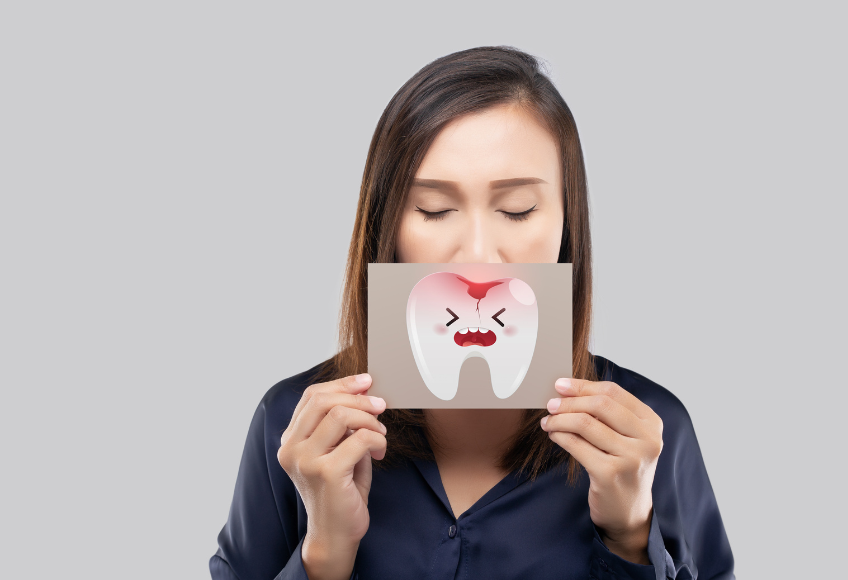
Periodontitis
Periodontitis, often referred to as periodontitis, is one of the most common causes of tooth loss. This inflammatory disease affects the tooth bed and arises from an excessive accumulation of bacteria in the form of dental surface and tartar. What initially begins as harmless gum inflammation can develop untreated into a serious disease that attacks the jawbone.
What is periodontitis?
Periodontitis, often referred to as periodontitis, is one of the most common causes of tooth loss. This inflammatory disease affects the tooth bed and arises from an excessive accumulation of bacteria in the form of dental surface and tartar. What initially begins as harmless gum inflammation can develop untreated into a serious disease that attacks the jawbone.
Share information about your brand with your Customers. Describe A Product, Make Announcements, Or Welcome Customers to your Store.
Causes and risk factors
The main cause of periodontitis are bacteria that accumulate as a plaque on the tooth surfaces. If this surface is not removed regularly, it hardens to tartar, which serves as a breeding ground for other bacteria. These release toxins that trigger inflammation.
In addition to inadequate oral hygiene, there are numerous other risk factors that promote the progression of the disease. Smoking is one of the largest risk factors. Nicotine narrowed the blood vessels, which reduces blood flow to the gums. This weakens the immune system and complicates healing after dental treatment. Studies show that a 50-year-old smoker has a similarly poor healing capacity as an 86-year-old non-smoker. Even after a smoke stop, it takes up to 15 years before the risk of tooth loss corresponds again to that of a non -smoker.
Diabetes mellitus is also closely related to periodontitis. People with poorly adjusted blood sugar levels have an increased risk of suffering from the disease. At the same time, existing periodontitis can further deteriorate blood sugar levels. This mutual influence makes thorough dental care particularly important for diabetics.
Other risk factors are genetic predisposition, chronic stress, hormonal changes (e.g. during pregnancy or in menopause) and an unbalanced diet with a high proportion of sugar.
Share information about your brand with your Customers. Describe A Product, Make Announcements, Or Welcome Customers to your Store.
Symptoms and course
The disease often develops gradually and painless, so that it is noticed late. A first warning signal is often bleeding gums, especially when brushing your teeth or eating hard foods. Other symptoms include persistent bad breath, swollen or reddened gums, gum return and an increased loosening of the teeth.
In the advanced stage, pus collections between the tooth and gums can even form. The gum hem offers bacteria protection so that you can multiply there undisturbed. If the dental laying (plaque) remains too long, the bacteria attack the tissue. Your body reacts with a defense reaction, in which bones are also broken down - this can lead to tooth loss in the long term. As long as the immune system is strong enough, it keeps the bacteria in chess. But when the balance is shifting, the inflammation progresses. This happens slowly with the chronic form, with aggressive periodontitis, the bone can be severely damaged within a short time.
Signs:
• Early: bleeding gums, redness, swelling
• Advanced: bad breath, pus formation
• Late: gum return, loose or shifted teeth
Share information about your brand with your Customers. Describe A Product, Make Announcements, Or Welcome Customers to your Store.
diagnosis
Periodontitis is diagnosed with a comprehensive dental examination. Since the disease often develops gradually and initially causes hardly any complaints, thorough diagnosis is crucial to recognize it early and to avoid serious consequences. The first step towards diagnosis is therefore the medical history, i.e. the collection of medical history. The dentist asks targeted questions about your general health, existing diseases and possible risk factors. This includes, for example, diabetes mellitus, smoking, stress or a family disposition. Questions about oral hygiene, nutritional habits and the use of dental floss or brushes are also important in order to get a complete picture.
The dentist then checks the gums for typical inflammatory signs such as redness, swelling and bleeding gums. The condition of the teeth itself is also examined, since loose or shifted teeth can indicate advanced periodontitis. A particularly important part of the examination is the measurement of the gum pocket depth with a special periodontal probe. The probe is carefully inserted between the tooth and gums to determine the depth of the so -called "parodontal pockets".
• Healthy gums has a pocket depth of 1–3 mm.
• Early stages of periodontitis show bags of 4–5 mm.
• Advanced periodontitis exists when the gum pockets are above 6 mm deep.
The deeper the gum pockets are, the stronger the surrounding tissue is already affected and the more difficult it becomes cleaning due to domestic dental care. In addition, tooth mobility is also tested. In severe cases of periodontitis, the teo stopping can be reduced so much due to bone breakdown that they loosen up noticeably.
X -rays: make bone loss visible
Since periodontitis can not only attack the gums, but also the jawbone, X -rays are an indispensable part of the diagnosis. They help to assess the extent of the bone loss and to determine whether the inflammation has already spread to the jawbone.
Microbiological tests: identification of harmful bacteria
In some cases it could make sense to carry out additional microbiological tests. These tests serve to analyze the exact composition of the bacteria in the gum pockets and to take precedence against particularly aggressive pathogens. For this purpose, a sample is removed from the gum pocket and examined in a laboratory. Certain bacterial strains, such as porphyromonas gingivalis or aggregate actor actinomycetemcomitans, are particularly dangerous and can accelerate the course of the disease. If such bacteria are detected, the dentist can consider targeted antibiotic therapy to combat the pathogens. Microbiological tests are particularly useful for patients with aggressive or recurring periodontitis forms. Even if the disease does not heal despite thorough treatment, a more precise analysis of the bacterial flora can be helpful.
Share information about your brand with your Customers. Describe A Product, Make Announcements, Or Welcome Customers to your Store.
Treatment options
• The therapy of periodontitis pursues two goals: eliminating the inflammation and the long -term stabilization of the tooth keeper apparatus. First of all, professional tooth cleaning is carried out to remove the dental panel and tartar. The gum pockets are also thoroughly cleaned. In severe cases, deeper cleaning under local anesthesia may be necessary. In addition to mechanical cleaning, there are also supportive measures such as antibiotics that act specifically against certain bacterial strains.
• Consistent healthy eating without factory sugar and white flour products. In addition, the diet should be supplemented with high -quality antioxidants in order to counteract inflammation. Taking Omega 3 fatty acids is also helpful.
• An oil rinsing with high -quality olive oil can also be carried out twice a day. On the one hand, this acts like a massage on the stressed gums and on the other hand, the metabolic poisons of the bacteria are to be pulled out of the gums.
• Further measures: intestinal renovation, deacidification, germ reduction by mouthwashes, rinsing with regulates.
Share information about your brand with your Customers. Describe A Product, Make Announcements, Or Welcome Customers to your Store.
Image with text
Italian herbs
- spicy aroma for culinary enjoyment
- the best choice, to let your creativity run free when cooking
- more intense Fragrance from Oregano, Thyme and basil
Simply season the pasta, vegetable and meat dishes with the taste "to the south". The Italian herbs conjure up Delicious Mediterranean dish on your plate.
Periodontitis and histamine
Histamine is always related to inflammatory processes in the body - therefore it is obvious that it is also important for periodontitis. Scientists have already examined whether the histamine level in saliva could be used as a marker for the diagnosis. The first studies show that people with periodontitis often have higher histamine values in saliva. However, there is a large fluctuation, especially for smokers, which generally have increased histamine values. Therefore, histamine is not reliable as a diagnostic marker alone. A combination of various inflammatory markers will probably be more meaningful in the future.
Histamine is also discussed in the area of treatment. The active ingredient Cimetidine, a so-called histamine receptor antagonist, could possibly help to dampen the inflammatory reaction. Animal experiments show that Cimetidin can lower the inflammation values and slow down bone loss. Initial clinical studies indicate that it could support the immune system in the mouth in the form of a mouthwash solution. But before Cimetidin is a fixed therapy option, many further examinations are necessary.
Share information about your brand with your Customers. Describe A Product, Make Announcements, Or Welcome Customers to your Store.
Periodontitis and their effects on general health
Periodontitis not only affects oral health, but can also have a negative impact on the entire body. Scientific studies show relationships between periodontitis and various systemic diseases.
• In this way, inflammation significantly increases the risk of cardiovascular diseases. A Swedish study showed that people with periodontitis have a 30 % higher risk of a heart attack. Women are particularly affected.
• There is also a dangerous interaction with diabetes. Untreated periodontitis worsens blood sugar setting and increases the risk of diabetic complications.
• Other diseases related to periodontitis are rheumatoid arthritis, dementia, cancer, lung diseases and inflammatory bowel diseases.
• An undiscovered periodontitis can even increase the miscarriage risk in pregnant women.
• In addition, knowledge of Covid-19: A study with almost 600 infected showed that patients with periodontitis had a risk of fatal course up to nine times.
Share information about your brand with your Customers. Describe A Product, Make Announcements, Or Welcome Customers to your Store.
Prevention
The best weapon against periodontitis is thorough and regular oral hygiene. This includes brushing your teeth twice, cleaning the interdental spaces with dental floss or interdental brushes as well as regular professional tooth cleaning at the dentist. It is particularly important to pay attention to risk factors such as smoking and poor nutrition. A low -vitamin, low -sugar diet can also significantly reduce the risk of periodontitis. Frequent dental control should not be left out for people with increased risk, such as diabetics or smokers.
Share information about your brand with your Customers. Describe A Product, Make Announcements, Or Welcome Customers to your Store.
Collapsible content
SOURCES
- https://de.wikipedia.org/wiki/Parodontitis
- https://www.pflege.de/krankheiten/parodontitis/
- Book "Histamine intolerance" by Prof. Reinhart Jarisch

From those affected for those affected
We are Thomas and Michaela Zinser, founder of Histaminikus.
Because of the own histamine intolerance of Michaela and our son, we founded Histaminikus. The frustration does not find any suitable histamine food has spurred us to develop low -histamine food.
We would like to give you back a piece of quality of life. Feel free to look around with us.
Kind regards
Thomas and Michaela







